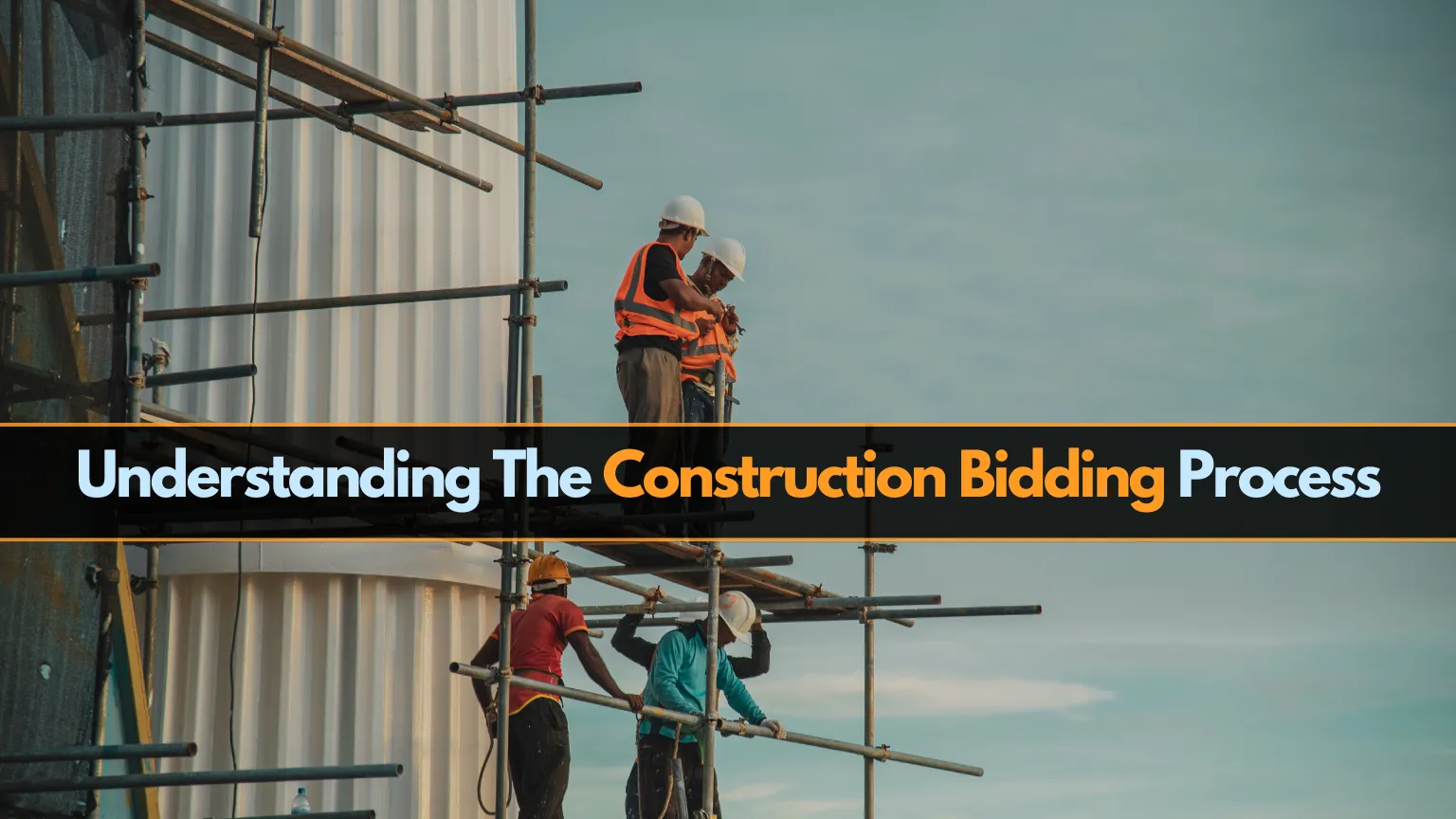When it comes to construction, bidding is an important element since it opens a way for clients and contractors to join hands and bind their activities positively to smooth progress in future projects. Every contractor vying for projects or client searching for the right team for his project should understand this process to ensure success. This article will discuss the construction bidding process, focusing on its steps and types of bids, common challenges, and some tips that both contractors and clients can learn from.
What is Construction Bidding?
Construction bidding is the entire process through which contractors tender their services, including costs and timelines for a project, to a customer. Several contractors compete amongst themselves to arrive at what they consider the best balance for cost, quality, and efficiency. After evaluating bids, clients select the most suitable contractor to deliver their projects within the foreseen budget and schedule.

Different types of Construction Bids
There are multiple types of construction bids, each of them suitable for different project needs and procurement methods. There are generally three types of construction bids:
Open Bid (Public Bid)
In an open or public bid, the project owner requests all interested contractors to bid on the project. A tender bid like this is often used for projects in the public sector, where transparency and fairness are intrinsic. The process is open to all contractors, and the lowest responsible bidder is generally given the project according to the minimum requirements as laid out in the bid documents. This method of selection makes sure that the process is competitive and free from bias.
An Invitational Bid
It is invited only by a few contractors who are either pre-qualified or recommended to the project owner, unlike an open bid. It is often used as a way of in-house projects in the private sector, where the owner wants to select the bidders according to their requirements. Although this does create less competition than open bidding, it allows the owner to work with contractors they already know and trust or are industry specialists in a certain type of construction.
Negotiated Bid
When the project owner selects a contractor and negotiates terms with them directly as opposed to performing a formal bidding process, it is usually done for projects that are complex, require niche skills or in situations where the timing of the project is crucial. The contractor is selected based on their qualifications (i.e. experience and past performance), and the terms of the contract (such as cost and schedule) are settled by negotiation.
Design–Build Bid
A single contractor handles both design and construction responsibilities to streamline the project. This method simplifies the process as one party takes care of the entire project, which can facilitate communication, decrease the threat of conflicts, and quicken the project delivery. Contractors are chosen based on their ability to provide quality design and construction services, and the bid generally includes a proposed design concept, cost estimates, and construction timelines.
Lump Sum Bid
A lump sum bid (or fixed-price bid) is when a contractor gives a single, fixed rate for the entire territory of work. This is the type of bid that works best if the project scope and specifications are well-defined. The contractor agrees to complete the project for the specified sum and usually bears the risk of any cost overruns. This gives the project owner certainty about the price but also assigns the risk of cost overruns to the contractor.
Unit Price Bid
The contractor places a unit price bid on a project that provides a price per unit rather than a lump sum bid, for instance, per square foot, linear foot, etc. In a situation where the amount of work to be performed is uncertain or if the scope of work needs some clarity, this is the type of bid commonly used. The project owner can then modify quantities over the course of project work, and the total becomes due upon completion of actual work.
Cost-Plus Bid
A cost-plus bid structure would allow the contractor to be paid for the actual project costs incurred during construction, plus an additional amount for overhead and profit. The charge might be either a flat rate or a portion of the overall expense. This kind of bid is suitable for projects with an undefined scope or when there is a requirement for flexibility. However, it does put most of the financial risk on the owner if the project runs into unexpected problems or delays.
Key Steps in the Construction Bidding Process
The construction bidding process consists of several key steps that help to ensure a fair and competitive selection of contractors for a construction project. Here’s a guide to those steps:
Project Planning
During the initial stage of the bidding process, the project owner presents their scope of work and creates detailed project plans and specifications. This involves defining the project timeline, budget, and the technical requirements for the construction project. Creating definitive, comprehensible documentation to clearly explain the project’s expectations to all bidders is the crux of this stage.
Invitation to Bid
The owner or project manager sends out an invitation to bid (ITB) once the project is finalized. This document details the bidding process and submission requirements, as well as the submission deadline. Invitations are usually only sent out to a list of pre-qualified contractors, though public projects may include an open invitation to all interested contractors.
Pre-Bid Meeting
Some bids are accompanied by a pre-bid meeting or, in some instances, a site visit. This stage gives prospective contractors the chance to ask questions and seek precise project instructions. At this meeting, they can also view the site to see what conditions and challenges they might need to face when bidding, which allows them to give more accurate bids that are competitive.
Submission of Bid
The project documents are produced by the contractors, who then submit their bids. A typical bid will include the cost proposed by the contractor to complete the job, potential timelines for the project, and terms and conditions. It may also enable contractors to offer alternatives or value-engineering options that lower costs or enhance the project.
Bid Evaluation
In the bid evaluation stage, the customer assesses all bids based on criteria defined earlier.
- Price is cost reasonable and straightforward to accept the bid.
- Requirements assessing the qualifications of the bidder and their experience as a general contractor.
- Technical criteria how creative and practical is the solution proposed and how well does it fit to meet project objectives.
- Compliance includes actions that need to follow all relevant state and national regulations, specifications in the safety code and residual project hazards.
- The leading bidders may be asked to interview or present at this point to provide clarification or answer questions.
Contract Award
After evaluating all bids, the project owner awards the contract to the successful bidder. The determination could be on the lowest cost, only value, or other elements like specialized experience and previous performance. A contract is negotiated and signed after the election, and the terms, schedule, and payment details are outlined.
Contract Negotiation and Finalization
The successful bidder and the owner negotiate and finalise the terms of the construction contract. That includes negotiating terms around schedules, payment, and any final adjustments to the scope of work. After both parties agree on the terms of the contract, it can be executed, and the construction work can begin.
Post Award Monitoring & Management
Once the contract is awarded, the construction, monitoring, and management of the project happens throughout the construction period to ensure that the project is being completed according to timelines, budget, and quality.
General Issues in The Bidding Process
Short timescales: Short-time scales may lead to mistakes or parts of a bid being left out.
Incorrect estimates: Time and cost estimates, if miscalculated, can lead to loss-making contracts and unnecessary project overspending.
Competitive Pressure: Quality is sometimes put at risk when very competitive pricing becomes hyper-critical.
Compliance Requirements: You will be disqualified for attempting to dodge client requisites or the regulations.

Advices for Successful Construction Bids
For Contractors
Focus on Accurate Budgeting: Use proper planning tools and consult with experienced project managers to give estimates that reflect actual costs and timelines
Show What You Offer: Provide your special qualifications, former assignments, and any other service that will help with the job.
Know your Client: Customize your proposal to emphasize your client’s priorities — whether it’s sustainability or cutting-edge methodologies.
Do Not Underbid: Competitive pricing is a great thing, Always! However, make sure that it is realistic and sustainable.
Build Relationships: Networking with clients and other contractors means you get the inside scoop on new opportunities before anyone else does, plus you create a sense of trust.
Focus: Focus on one area of expertise that you can become expert in and perfect your craft.
For Clients
Be UpFront: Contract as much about the project as you can to attract legitimate contractors and reduce misunderstandings.
Beyond Price: In assessing bids, look at experience, reputation and creativity
Be Transparent: Communicate openly and regularly to answer any questions or address any concerns while you are working through the process.
Do it Fairly: Once you give it to different bidders, establish a fair evaluation system so that all bidders remain on the same level.
Final Words
To sum it up, the construction bidding process is an important aspect of the construction projects for both the clients and the contractors. It includes steps of project definition, solicitation of bids, analysis of proposals, and project startles. Clarity in expectations and criteria allows everyone to have a level playing field during the bidding process. Such transparency not only ensures healthy competition but also favours choosing the best-qualified contractor to deliver the project successfully. All in all, a properly supervised bidding process serves as the basis for a successful construction project in which everyone benefits.

